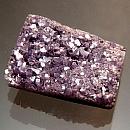|
ClassicGems.net |
|
|
 |
|
Amesite |
|
|
Discovered in 1876; IMA status: Valid (pre-IMA; Grandfathered) |
|||
|
|
|
Chemistry |
|
|
|
|
|
Mg2Al(SiAl)O5(OH)4 |
|
|
|
Magnesium Aluminum Silicate Hydroxide |
|
Molecular Weight: |
278.68 gm |
|
Composition: |
Magnesium |
17.44 % |
Mg |
28.92 % |
MgO |
|
|
Aluminum |
19.36 % |
Al |
36.59 % |
Al2O3 |
|
|
Silicon |
10.08 % |
Si |
21.56 % |
SiO2 |
|
|
Hydrogen |
1.45 % |
H |
12.93 % |
H2O |
|
|
Oxygen |
51.67 % |
O |
|
|
|
|
|
100.00 % |
|
100.00 % |
= TOTAL OXIDE |
|
|
|
||||
|
Classification |
|
|
|
|
|
Silicates (Germanates) |
|
|
8/H.27-100 |
|
|
|
9 : SILICATES (Germanates)
|
|
Related to: |
Serpentine Group (also known as Kaolinite-Serpentine Group). Several polytypes are known: 2H1, 2H2, 6R and others. In 1976 it was reported in volume 61 of the American Mineralogist that Amesite had the first reported natural occurrence of the 6R polytype for a trioctahedral 1:1 layer silicate. |
|
Members of Group: |
Serpentine Group: Amesite, Antigorite, Baumite, Berthierine, Brindleyite, Caryopilite, Chrysotile, Clinochrysotile, Cronstedtite, Dickite, Fraipontite, Greenalite, Halloysite, Kaolinite, Kellyite, Lizardite, Manandonite, Nacrite, Népouite, Odinite, Orthochrysotile, Parachrysotile, Pecoraite, Vorhauserite |
|
Varieties: |
Chromian Amesite, Ferroamesite |
|
Synonyms: |
Amenite, Amensite, Amesine, Septeamesite |
|
|
|
|
Crystal Data |
|
|
|
|
|
As tapering pseudohexagonal prisms elongated along [001], to 2 mm; also tabular. |
|
|
Common as six-fold sector twins on {001} and polysynthetic twins || {010} prism edges. |
|
|
|
|
|
Physical Properties |
|
|
|
|
|
Perfect on {001} |
|
|
Irregular/Uneven |
|
|
Brittle |
|
|
2.5 - 3.0 |
|
|
2.77 - 2.78 (g/cm3) |
|
|
None |
|
|
Not Radioactive |
|
|
|
|
|
Optical Properties |
|
|
|
|
|
Colorless, white or pale green; pink to lilac (chromian) |
|
|
Transparent to Translucent |
|
|
Resinous, Waxy, Greasy, Sub-Metallic; Pearly to somewhat Metallic on cleavage surfaces. |
|
|
1.597 - 1.615 Biaxial ( + ) |
|
|
0.015 - 0.018 |
|
|
Weak; r < v |
|
|
None |
|
|
|
|
|
Occurances |
|
|
|
|
|
Geological Setting: |
A product of low-grade metamorphism of Al, Mg-rich rocks. |
|
Common Associations: |
Vesuvianite, Chlorite (Pensacola Mountains, Antarctica); Magnetite, Rutile, Diaspore (Chester, Massachusetts, USA); Grossular, Calcite, Diopside, Clinozoisite (Black Lake, Canada). |
|
Common Impurities: |
None |
|
Type Locality: |
Chester Emery Mines, Chester, Hampden Co., Massachusetts, USA |
|
Year Discovered: |
1876 |
|
View mineral photos: |
|
|
|
|
|
More Information |
|
|
|
|
|
|
|
|
|
|
|
Amesite was discovered in 1876 and named by Charles Upham Shepard in honor of James Tyler Ames (1810 - 1883), who was an American inventor and part owner of the Chester Emery Mines in Massachusetts and had a rare and unusual collection of minerals. Amesite is a relatively rare phyllosilicate mineral that is found in only a few locations worldwide. Amesite is usually found in colors of white or colorless or pale green. However, at the occurance at the Saranovkii Mine, Urals Region, Russia Amesite crystals are found in beautiful shades of pinks and lilacs to purples. The colors are due to the presence of chromium (Cr) in the Amesite formula. And as it turns out, these attractive crystals have grown on solid black Chromite. These colorful crystals can be called "Chromian Amesite". Although Amesite crystals are typically too small to be faceted, the Russian Chromian Amesite can be formed into beautiful druzy-style gems covered in short, sparkling purple crystals. Sometime after its discovery, Amesite was considered to be a variety of Chlorite and re-named Corundophilite. Amesite was re-established as a distinct species by E. V. Shannon in 1920, although he continued to refer to Amesite as a Chlorite. Dr. J. W. Gruner demonstrated in 1944 that Amesite is a Serpentine. Amesite is now a member of the Serpentine Group of minerals that includes other gem-type minerals such as Antigorite and Lizardite. Locations for finding Amesite are the Type Locality at the Emery mine, Chester, Hampden County, Massachusetts, USA. From the Lake Asbestos mine, Black Lake, Quebec, Canada. In Antarctica, in the Dufek mafic massif, Pensacola Mountains. From the Postmasburg manganese deposits, Cape Province, South Africa. From Russia, at the Saranovskoye chromite deposits, Northern Ural Mountains. At Hällefors, Sweden. On Mt. Sobotka, Silesia, Poland. |
|
|
Amesite gems for sale: We have not photographed our Amesite gems yet. Please check back soon. |